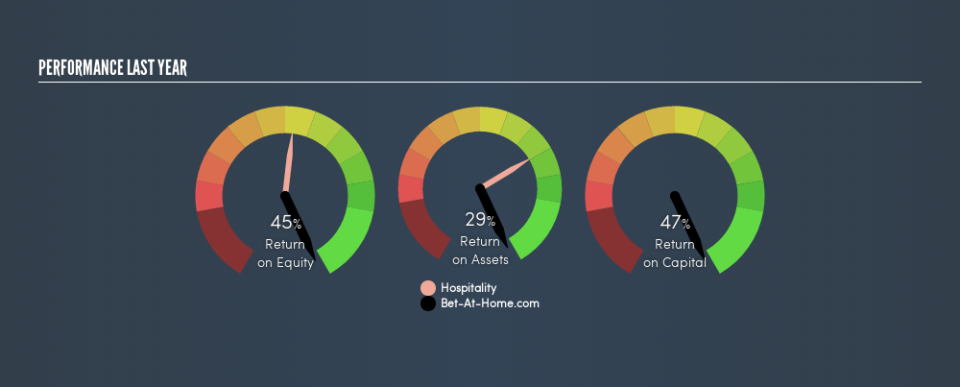Here's What Bet-At-Home.com AG's (ETR:ACX) ROCE Can Tell Us

Want to participate in a short research study? Help shape the future of investing tools and you could win a $250 gift card!
Today we are going to look at Bet-At-Home.com AG (ETR:ACX) to see whether it might be an attractive investment prospect. Specifically, we're going to calculate its Return On Capital Employed (ROCE), in the hopes of getting some insight into the business.
First of all, we'll work out how to calculate ROCE. Then we'll compare its ROCE to similar companies. Then we'll determine how its current liabilities are affecting its ROCE.
What is Return On Capital Employed (ROCE)?
ROCE is a measure of a company's yearly pre-tax profit (its return), relative to the capital employed in the business. All else being equal, a better business will have a higher ROCE. Overall, it is a valuable metric that has its flaws. Renowned investment researcher Michael Mauboussin has suggested that a high ROCE can indicate that 'one dollar invested in the company generates value of more than one dollar'.
So, How Do We Calculate ROCE?
Analysts use this formula to calculate return on capital employed:
Return on Capital Employed = Earnings Before Interest and Tax (EBIT) ÷ (Total Assets - Current Liabilities)
Or for Bet-At-Home.com:
0.47 = €38m ÷ (€118m - €38m) (Based on the trailing twelve months to March 2019.)
Therefore, Bet-At-Home.com has an ROCE of 47%.
Check out our latest analysis for Bet-At-Home.com
Does Bet-At-Home.com Have A Good ROCE?
ROCE can be useful when making comparisons, such as between similar companies. In our analysis, Bet-At-Home.com's ROCE is meaningfully higher than the 5.8% average in the Hospitality industry. I think that's good to see, since it implies the company is better than other companies at making the most of its capital. Regardless of the industry comparison, in absolute terms, Bet-At-Home.com's ROCE currently appears to be excellent.
In our analysis, Bet-At-Home.com's ROCE appears to be 47%, compared to 3 years ago, when its ROCE was 34%. This makes us think about whether the company has been reinvesting shrewdly.
Remember that this metric is backwards looking - it shows what has happened in the past, and does not accurately predict the future. ROCE can be deceptive for cyclical businesses, as returns can look incredible in boom times, and terribly low in downturns. ROCE is only a point-in-time measure. What happens in the future is pretty important for investors, so we have prepared a free report on analyst forecasts for Bet-At-Home.com.
What Are Current Liabilities, And How Do They Affect Bet-At-Home.com's ROCE?
Short term (or current) liabilities, are things like supplier invoices, overdrafts, or tax bills that need to be paid within 12 months. Due to the way the ROCE equation works, having large bills due in the near term can make it look as though a company has less capital employed, and thus a higher ROCE than usual. To check the impact of this, we calculate if a company has high current liabilities relative to its total assets.
Bet-At-Home.com has total liabilities of €38m and total assets of €118m. As a result, its current liabilities are equal to approximately 32% of its total assets. Bet-At-Home.com has a medium level of current liabilities, boosting its ROCE somewhat.
What We Can Learn From Bet-At-Home.com's ROCE
Despite this, it reports a high ROCE, and may be worth investigating further. Bet-At-Home.com shapes up well under this analysis, but it is far from the only business delivering excellent numbers . You might also want to check this free collection of companies delivering excellent earnings growth.
I will like Bet-At-Home.com better if I see some big insider buys. While we wait, check out this free list of growing companies with considerable, recent, insider buying.
We aim to bring you long-term focused research analysis driven by fundamental data. Note that our analysis may not factor in the latest price-sensitive company announcements or qualitative material.
If you spot an error that warrants correction, please contact the editor at editorial-team@simplywallst.com. This article by Simply Wall St is general in nature. It does not constitute a recommendation to buy or sell any stock, and does not take account of your objectives, or your financial situation. Simply Wall St has no position in the stocks mentioned. Thank you for reading.

